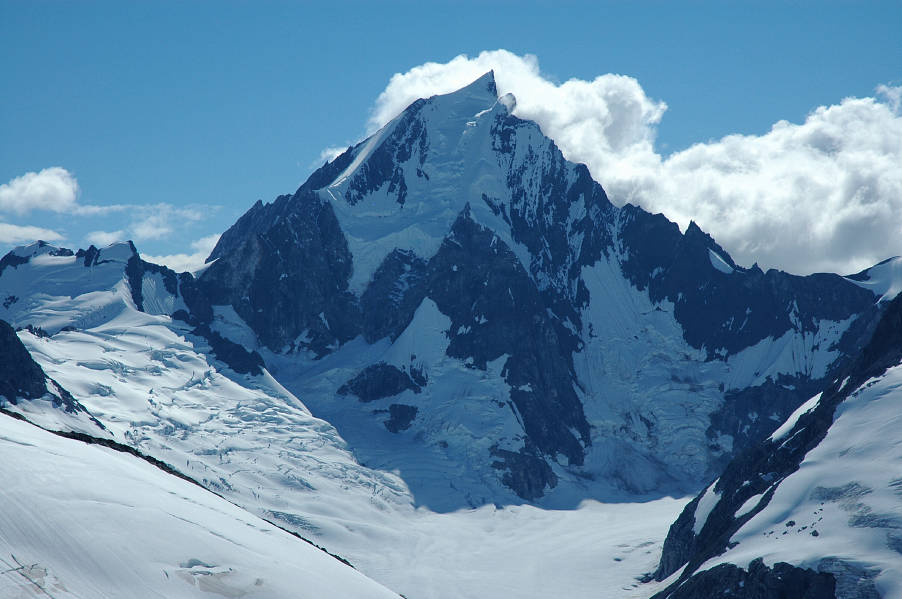Sixty Seven Fords and a Col
August 9, 2007
The dark cabin couldn't tell me anything. I had to stick my head outside to see for myself. The sky over head was clouded and misty, but in a good sort of way. We would fly today. A light rain came down, but couldn't dampen by confidence or melt away any of the anticipation that I felt. We would fly today. Mike and Bob were up and about and after a bit of stumbling about, we moved over to the kitchen to see if we could get some breakfast, hopefully in less than the 90 minutes that our hamburgers took yesterday. The pretty owner took our order of omelets and hashbrowns before scurrying back to the mother-in-law, who was again doing the cooking. Doug, our pilot, strolled in shortly after with good news: Telegraph Creek, to the north and west of us, was clearing and he suspected that we would be able to fly in an hour or two. Enjoy your breakfast, he told us. This would be our last real meal, made with actual ingredients for three weeks. The mother-in-law brought the greasy egg-burritos to us just as Doug left, dropping the plates off at our table with barely a word. It wasn't clear that they would be in business when we returned. If we returned.
After eating we drove our gear down to the lake and began the process of loading up the plane. Three heavy, bulging packs stuffed to capacity. Three fifty five liter dry bags jammed with food. Four aluminum pickets. Nine ice axes and tools. Three canisters of bear spray. The little float plane was filled with all of the material that we though we might need to survive for three weeks on the Scud and its outflow. If we had a guidebook, if this was a heavily explored area, if we knew what the weather was going to do or what the snow conditions were like or how open crevasses were or how solid the rock was or where rappel stations were or even how far things were, we could have dispensed with half of what we had. But we didn't. Nobody knew such things. And so we brought several hundred pounds of gear and food and hoped we had what we needed.
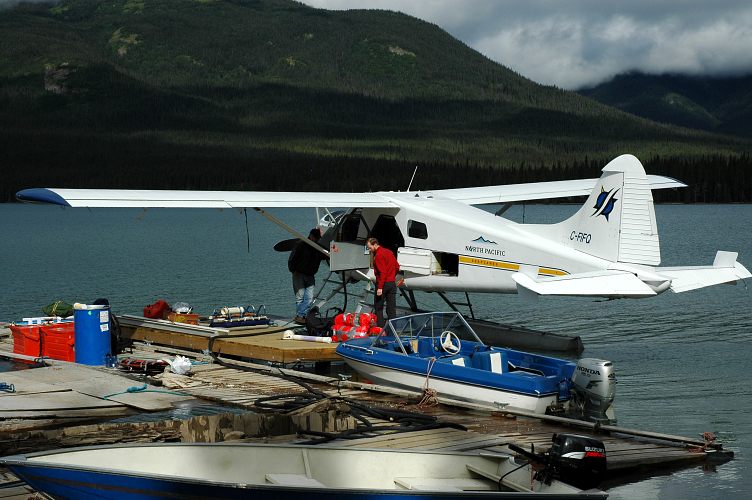
Before you read any further, you should take note of something that I wrote in the first paragraph just after we ordered the grease tacos from the mother-in-law: Doug is our pilot. Now, Doug flies lots of people to lots of places, but I'd like to think that he likes us the best. Doug has been flying out of Tatogga Lake, now officially for North Pacific Seaplane, for about a decade. Before that he flew out on the coast, out of places like Bella Coola and Prince Rupert. I can still remember my first plane ride with Doug back in the summer of 2001, when myself, Mike, John, and Kevin headed into Arctic Lake for a traverse north across the Spectrum Range and Mount Edziza Provincial Park to Buckley Lake. Doug had never flown into Arctic Lake, but was game for giving it a shot. As we flew toward the mountains, Doug held a map over his knees as he steered. Moving up one valley, over a pass, and into another. "Hmm, this won't work," Doug said, as he found a valley with nothing but a mountain for a headwall. Calmly banking the plane around, Doug flew out the other end and over another pass. Doug was exploring in his plane just like you would on foot, except without all of the brush. I flew with Doug the next year as well at the start and end of a slightly disastrous trip to climb Mount Hickman. That beast of a mountain has seen one known ascent, by the legendary Fred Beckey, and other less legendary figures, though they took a helicopter in and avoided most of the approach difficulties. Maybe they are smarter than we are. Mike, John, and Volker returned in 2003, 2004, and added Kevin for 2005. And now we were back in 2007.
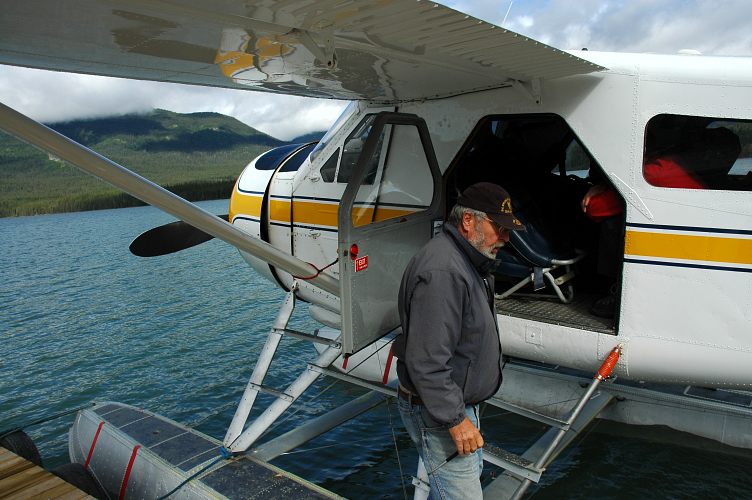
Mike got into the co-pilots seat, while Bob and I jammed into the back with the gear, trying not to stab ourselves on something sharp. We were clean, rested, and happy. Nothing had holes in it. Our bellies were full. It would be the last time. Doug did his pilot thing, pushing buttons and moving levers. He didn't bother to call in to air-traffic control. There wasn't any.
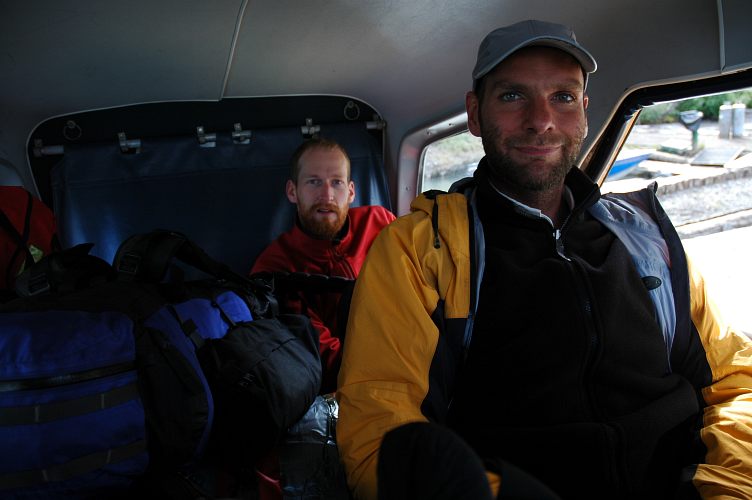
The clouds had lifted nicely when we took off from the lake and flew over the thick forest that dominates the non-glaciated land from Vancouver to Anchorage. You cannot possibly understand how thick this is unless you are unfortunately enough to have to walk through it for a while. You cannot understand how wild it is until you are plopped down in to it. It looked kind and pleasant from our vantage point of several hundred feet above it, but I knew it was more brutal than it looked.
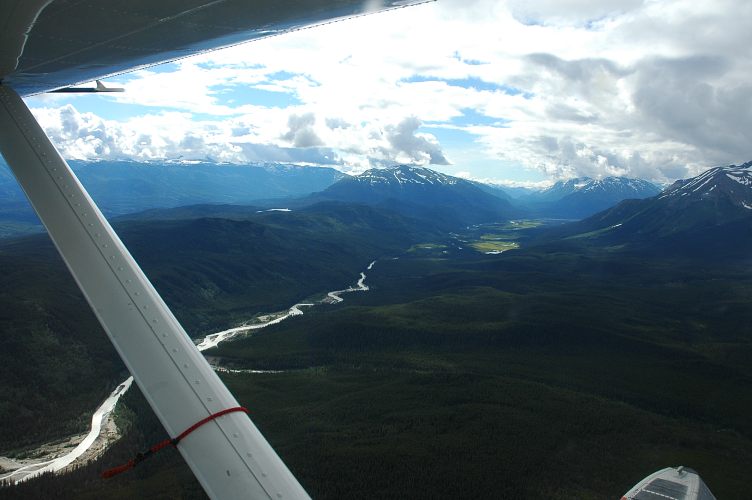
We flew into the mountains as the day got progressively more clear. And then we saw her. Mike turned around and waved, mouthing the words White Rabbit. It was distinct: A massively mantle of snow and ice gripping the left side of the peak. Mike, along with John and Volker, had made the the first ascent of the mountain via a straightforward snow and ice climb, with a little rock scrambling thrown in. Our first objective was to make the first ascent of the rock ridge (the west ridge) coming off the right side of the peak. It looked long, but low angle enough to make it feasible. The mountain looked far larger, and the west ridge far longer, than it had in the photographs that Mike and I poured over in Vancouver while drinking wine and beer, in safety and comfort.
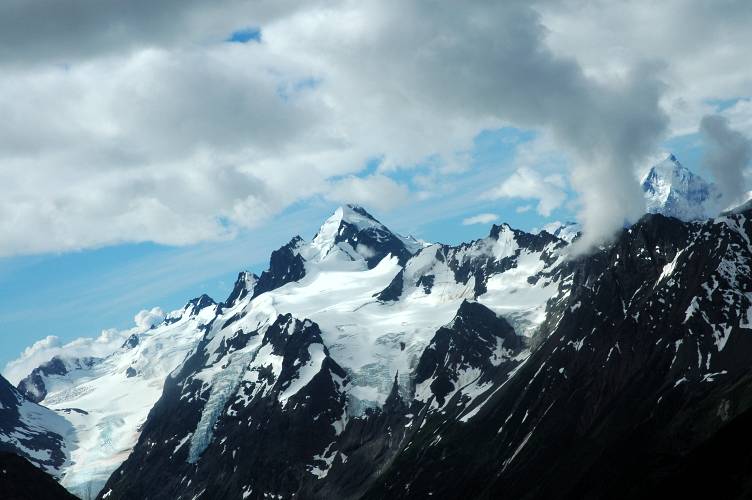
A bit further along we got our first view of Ambition, barely visible through the clouds, a massive,aesthetic peak with a formidable face on it that had never seen an ascent. The mountain itself had been climbed once before, in 1967 by a quartet of hardmen from the United States. The Hardmen had also climbed Endeavour, to the right of Ambition, and Dokdaon, to the right of Endeavour. We were going to try to climb some of these, but not until later in the trip. These three peaks made up the only officially named mountains in the immediate area, White Rabbit being a name hung on the peak by the Hardmen, who had not been able to climb it due to nasty weather and a shrinking food bag.

Yehiniko Lake was beneath us, the site of the last possible human contact we'd have for a long time. There was a crude hunting outfit on the far side of the lake, in case things got really bad and out satellite phone failed to work. Additionally, there was a hunter's trail leading from the camp out to the Stikine River, where it might be possible to flag a passing jet boat down for help. As far as escape plans went, it was really pretty shoddy work. Better not to need to escape at all.

Far up the lake was Yehiniko Creek and Valley, which we'd avoid taking due to serious bush. Mike and others had been up it in 2004 and found it difficult at best. However, there was another valley leading up to the Scud, that of Quattrin. In the above photo you can see it coming in from the right. Although Quattrin had many creek crossings, it was at least open and the travel easy. In a small plane,nothing happens fast. It felt like Doug cut the engines completely as we circled, gliding in toward the lake. There was an old landing strip cut through the woods joining Quattrin Creek with Yehiniko Lake, and we were aiming for that feature to walk through.

The plane hit the water and bounced. A second time. A third. We were down. Doug maneuvered us around the lake searching for the old air strip that had been so prominent from the air. This was more difficult to do than one might think, but eventually we rounded the right point of land and it came into site, an old, decrepit dock marking it for us. Doug eschewed the rotting bits of wood and hopped along the pontoon and out to dry land to pull the shallow draft plane to a secure spot. The smell overwhelmed me. After so much time spend inside, or in pseudo-wilderness, the smell of thousands of square kilometers of near virgin land was powerful. It took the mosquitoes five minutes to find us. Unfortunately for us, it took 10 minutes to unload gear and to get Bob rigged in as the bombardier for the food drop and to get moving again. As Doug taxied into the lake, we violently swatted the hoards of mosquitoes that had come into the plane with us. We swatted at them as we taxied. We swatted at them as we took off. We swatted at them as we cruised up Quattrin Creek.

The woman at MEC wasn't quite sure what to make of us and our plans.
Us: "We're going to thrown these here dry bags out of a plane several hundred feet down onto a glacier."
Her: "Well, err, I think most people use them in canoes and kayaks. They're not really meant to be thrown out of a moving plane. Let me know if it works"
Of course, if it didn't work, our trip would be pretty short. We had seven days of food on us and all of our fuel, all two gallons of it. But if the bags exploded on impact, or went into a crevasse, or got eaten by a wandering grizz, our trip would be cut rather short. If it looked too dangerous to drop, we'd have to carry all the supplies on our backs, in several stages, as there was too much for one push given the terrain. The bags held another 17 days of food and our rock protection. If we had to do carries, we'd easily lose three days, maybe four, in the effort.
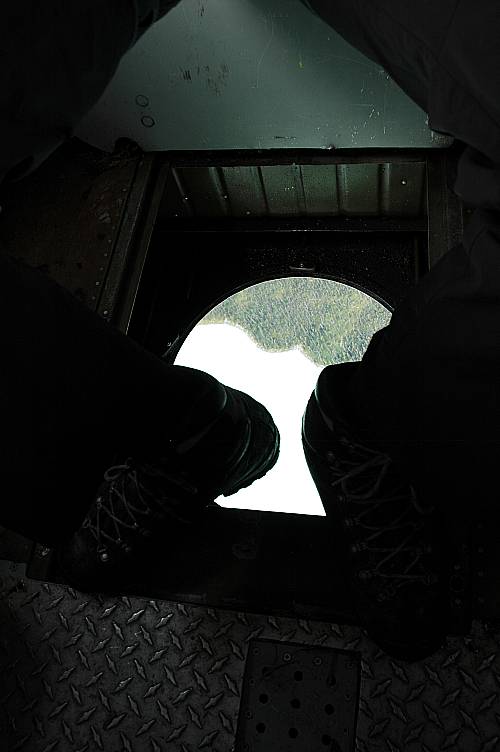
As we flew up Quattrin Valley, I tried to keep a sharp eye out on the terrain below. It looked quite open and Quattrin Creek seemed heavily braided. This might mean lots of wet, but shallow crossings. Or, it could be a nightmare. Either way we had to do it, and that was somewhat reassuring. But only somewhat.

Near the head of the valley we got, literally, a bird's eye view of where we'd be spending the next several weeks. The valley ended in a glacier that ran up to a rocky col. Beyond the glacier in the distance was Ambition, its radical shape, with white face, being unmistakeable. To the right (east) of the glacier and col were two brutal peaks, both of which were unnamed and unclimbed. We'd try to change that.

To the left (west) of the glacier and col was White Rabbit. The closer we got, the scarier it looked. There was no way we'd try to climb the face and icefall to the summit. The west ridge looked low enough angled, still, but numerous gendarmes (free standing rock pillars that block ones progress) could be seen along it. If we were lucky, the gendarmes could be bypassed. If we were not, we'd have to climb up and over every single one of them. In the below photo, the west ridge is the right skyline of the mountain.

Directly across from the col was the Scud and Ambition. The immense face we saw was actually two: The East and the Southeast. If Ambition was in the Himalaya, or Patagonia, or the Alps, or the Canadian Rockies, it would be considered a prime target. Since John Clarke died, and unless the Hardmen were still alive, we might be the only people to know of it and we weren't even going to try the face routes. Our idea was to sneak around the backside, just like the Hardmen had.
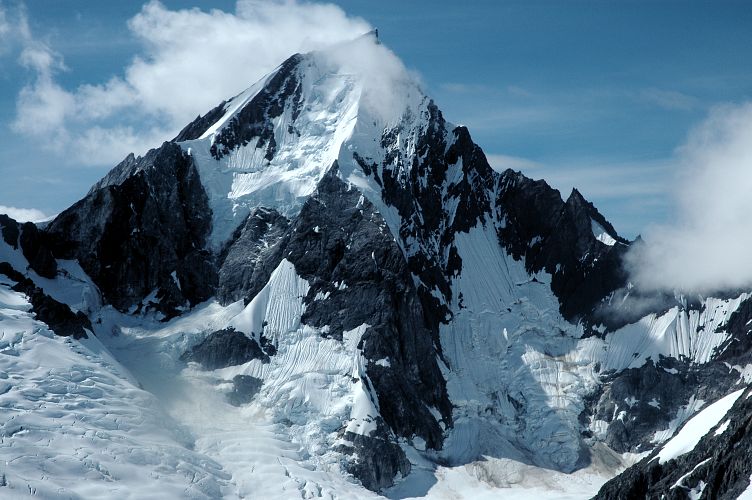
To the left of the plane, heading due south, was the mighty Scud glacier. A massive highway, it would provide us with a way out to the Stikine River. I smiled at its friendly appearance: The snow looked solid and the crevasses not to bad on the upper reaches. Lower down it seemed to turn to bare ice, which meant a lot of end-running, but not too much falling. The first stage of our exit looked good, and I smiled at the news.
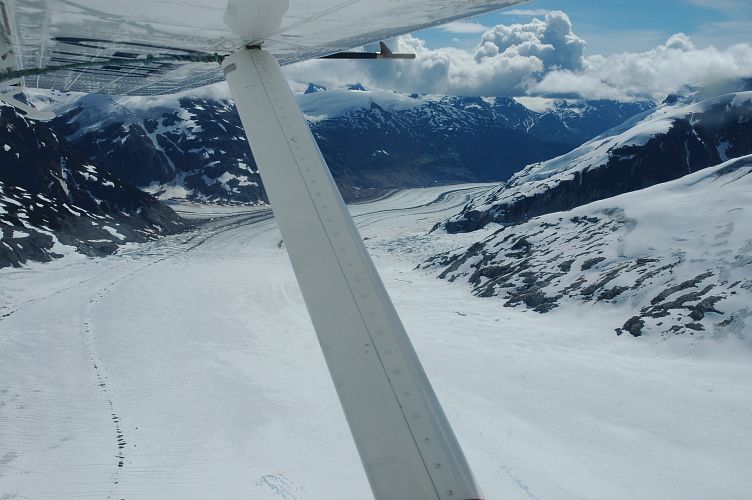
A bit further to the north, up the glacier, we spied the prominent peak of Dokdaon, supposedly the easiest of the three named peaks to climb. It had seen one ascent, period, and would hopefully see a second in a few weeks time. Several dark peaks loomed further north, ones we might give a run to.
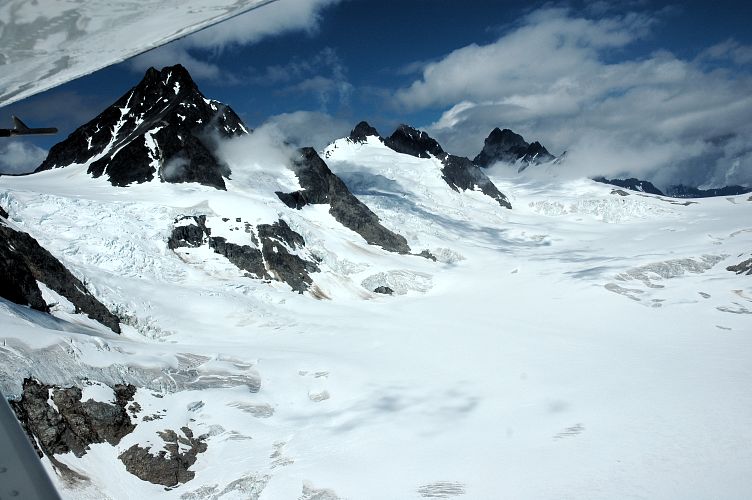
We circled around as Mike and Doug searched for a good place to drop the food bags. Near the base of Dokdaon would do nicely, as there seemed to be plenty of snow and few crevasses. Doug swung the plane around again and headed for the drop site. Bob and I got set and waited for the signal. Mike pointed to me and I patted Bob. The first bomb went. I handed Bob the second and it went down directly after the first. We dropped our third bomb. All three had gone out the plane within two seconds of each other. Bob and I watched nervously through the bomb hatch as the three red bags, re-inforced with duck tape, tumbled end over end toward the snow below. Time slowed. And slowed. And slowed. Finally they hit, bouncing a few times, and then coming to a rest. Bob and I let out a roar. They had landed intact. All smiles, we circled around so that Mike and Doug could spot them and put a GPS waypoint in, just in case it snowed. All agrin, we headed back to Yehiniko.

Doug set us down gently and then headed to the north side of the lake to pick up a raft and engine that two hunters he had flown in had left. Too cheap to pay for a return flight out, then had done their thing, then walked out to the Stikine via the hunter's trail and waited until a boat came by to pick them up. Given the people of the north, and the conditions, any boat that came along would give them a lift. That is how things work. Doug was then stuck hauling their boat out. We helped him load the abandoned material into the little plane. The bit of hefting was worth it, though. For, across the lake we would see new things that we couldn't from the air, new perspectives. Both Yehiniko and Quattrin valleys were seen, with the dominant White Rabbit just to the right of Yehiniko Valley. We had been there 15 minutes before. It would take us two solid days to return.
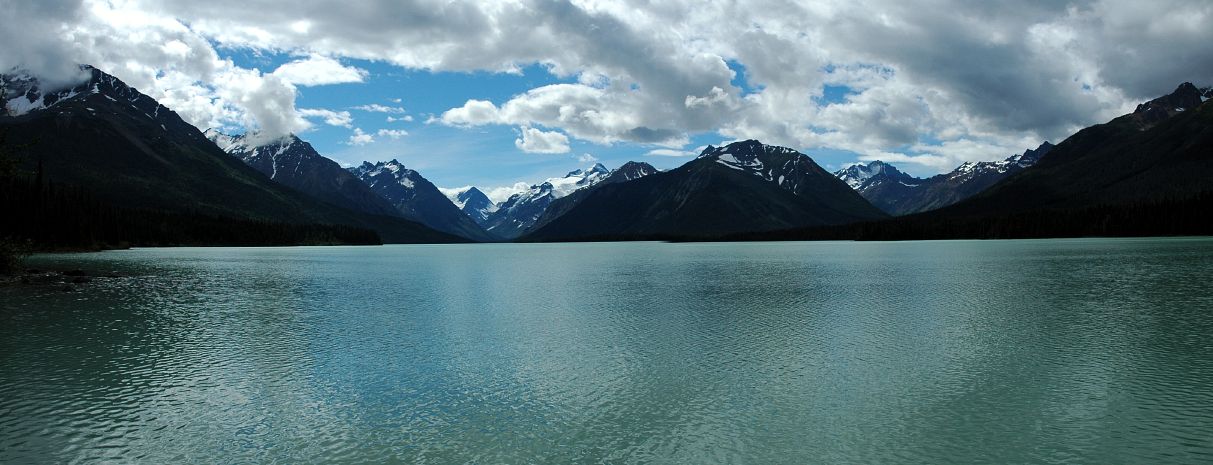
After loading the boat in, we taxied over to the old airstrip where Doug dropped us off. "See you in three weeks," he said cheerfully. Then he taxied out into the lake, gunned the engine, and was aloft rapidly. His plane gained elevation while circling, then headed up a valley and was out of site. We were alone. Except for the mosquitoes and ourselves. It was time to begin. When Thoreau said that he wanted to live deliberately, this is what he meant. There was nothing in the world except for us and the land. There was not Iraq. There was no Global War of Terror. There was no traffic, no affairs, no supermarkets, no billboards, no nothing except for what we brought and what we encountered. With the help of the land, we would shape our experience. Nothing else mattered.

After consuming some calories in a vain attempt to lighten our loads, and putting on DEET in an equally vain attempt to ward off the bugs, we shouldered our heavy loads and began the walk up the old air strip to Quattrin Creek. The airstrip lead through to some woods which we forced our way through and down to the gravel of Quattrin Valley.

A short stroll brought us to the first ford of Quattrin Creek. The view from the air had told us that it would be the first of many. With 70 pounds on your back and a milky creek in front of you, you don't even bother to think about taking your boots off. I picked up a stout stick, smiled, in a weakly confident way, at Mike and Bob, and waded into the channel. The rocks underfoot forced a slow, sure plod across. Balance is key, yet the load on my back conspired to thrown balance off. I've forded hundreds of creeks before and knew the routine. You shuffle your feet. You do not step. You do not fall. The water rose to my knees, then abated, and I was across without issue.
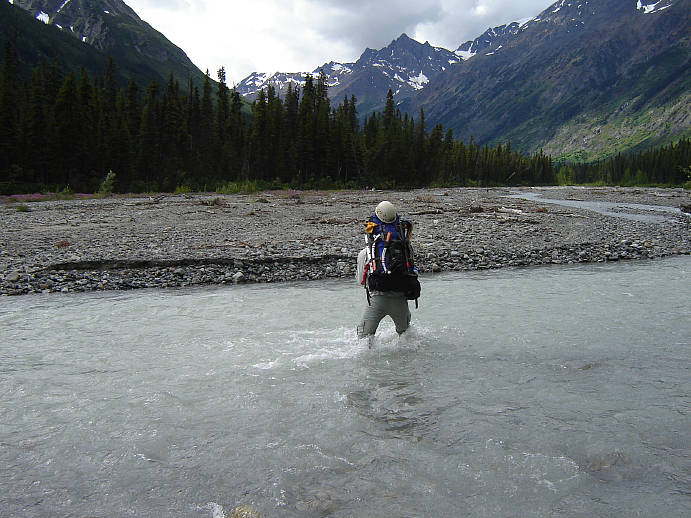
Mike came across next, declining to pick up a stick, and did the same slow shuffle. Although I've probably forded more creeks than Mike, he has definitely forded more glacial creeks than I have and he made it across without issue either.

And now it was Bob's turn. Bob had forded far fewer creeks and moved carefully, making sure of every step. He was a rookie at stream fording. In an hour, he'd be a veteran. Like Mike, he carried only his ice axe for support, but the water was far too deep to make it effective. After a few missteps, he made his way across and swapped his ice axe for a stick. We all smiled and headed up the valley to see what the land would have in store for us.

We made it a hundred yards before the next ford. And then another hundred yards of gravel walking before another. An hour later, we had put in forty of them.
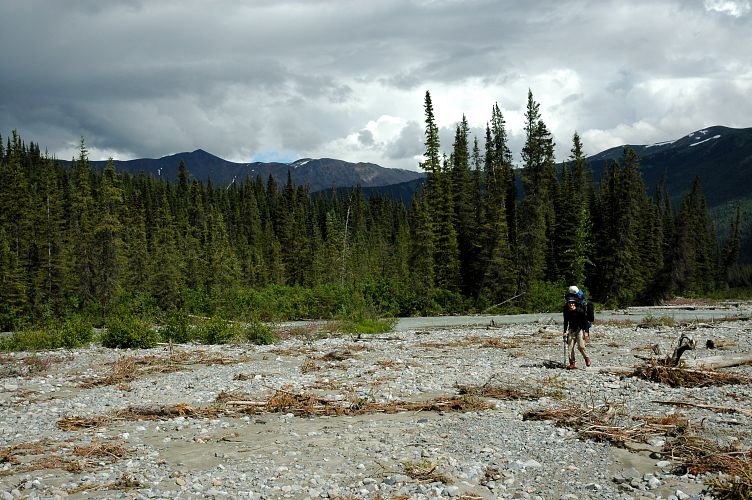
We rested on a log for a bit, admiring the views and drinking the glacial milk than was spilling off of the glacier that we were heading for, before setting off once again. Shortly out of our rest, Mike whispered,"Grizz.". Neither Bob nor I had seen it. But Mike has unusually good eyes for spotting something out of place, a skill that must be connected, somehow, to his ability as a mathematician. After a few seconds, Bob and I locked on to what he had seen. Far up the valley was a brown blob, moving slowly toward us, eating flowers and plants as it went.s

The bear had no idea we were here. The wind was blowing in circles, so he didn't smell us. The wind and our distance kept it from hearing us. Its bad eyesight kept it from seeing us. We stopped dead in our tracks and waited for it to come near, for it wouldn't divert from its easy course until it had to. Mike dropped his pack to fish out his 100-400mm lens to get close up shots. Having only a maximum 70mm at my disposal, I shot environmental shots, showing the bear in relation to the land, before putting my camera away and drawing my bear spray.
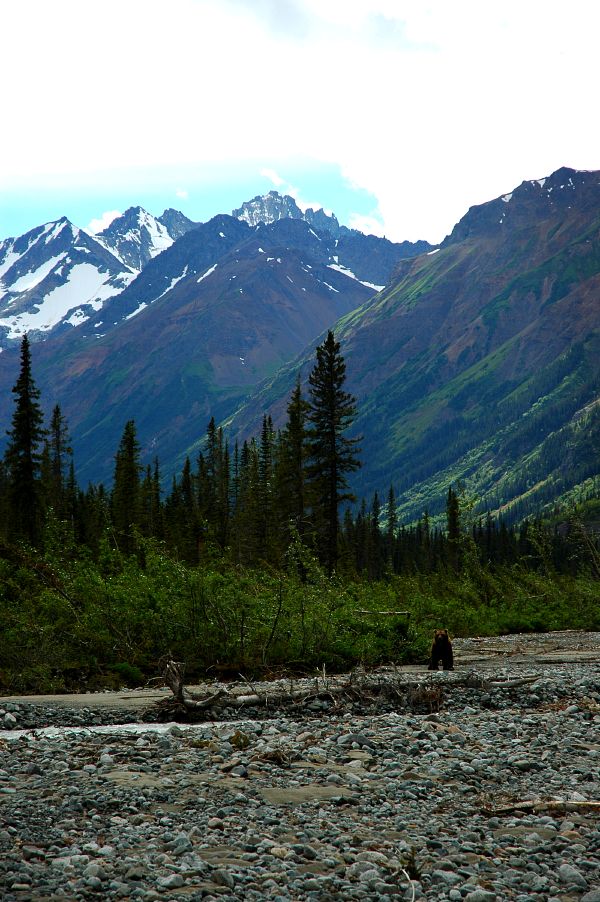
The bear drew nearer, breaking 200 yards, still unaware of our presence. As far as grizzlies go, it wasn't large. Maybe four hundred pounds. But even a medium sized grizzly could tear us to shreds.

Every grizzly encounter I've had, at least those in remote places, has gone exactly the same way: The bear realizes that there is something out of the ordinary. Rather than confront this thing, it chooses flight instead. The reason for this is survival.

Grizzly bears are territorial animals. Mid sized adolescents will be killed by larger, full grown adult males. It is more prudent, then, for an adolescent to flee something that he doesn't understand, or that doesn't make sense. Unless, of course, the bear is curious and wants to learn something new. Curious bears, like curious humans, are dangerous.

As the bear drew within seventy yards, it realized something was afoot. Not sure what it could be, as we were quiet and not moving, we could see it sniffing the air. It stood up for a better look, but could still not make out what we were. It might never have seen a human before, let alone three standing close together with big packs on.

It began wandering toward us, slowly, unsure of what to do or even if there was any danger. Zig zagging, it tried to figure out what was bothering its senses, what was telling it to run. When it got to within fifty yards, Mike bellowed out, "Hello Mister Bear!". The echo from the valley walls hadn't even come back to us before the bear had turned around and raced into the brush. It was out of site, and hopefully well out of our area.
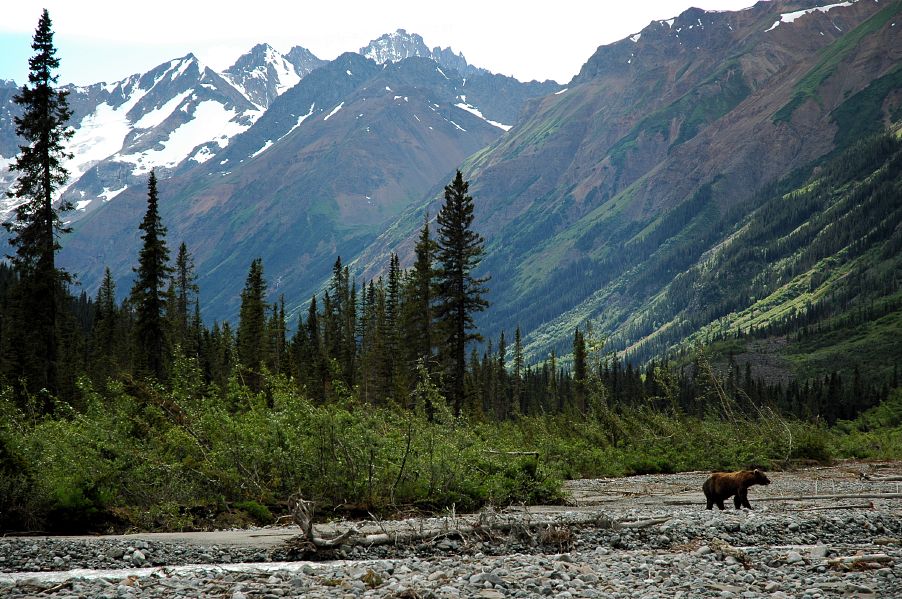
We proceeded up the valley to where the bear had stopped. A braid had to be forded, which meant that I had to put my spray away, take up my stick,and ford it. I would be rather vulnerable, especially as I needed to concentrate on the ford instead of the low brush in front of me. Mike and Bob kept a look out as I forded. When I reached the other side, I redrew my spray and watched while Mike and Bob came across. We moved away rapidly.
Another hour, and another thirty fords or so. All exactly like the others. Slow, shuffling feet. More like a beast. Be unstoppable. And then Mike took a dunking. In a braid like any other, he had neared the far side in mid-thigh deep water when a rock unexpectedly rolled under his foot and down he went. I sprang, as much as a human with 70 pounds on their back can spring, to the bank, into the shallow water near it, and tried to use my stick to reach Mike. After going under a bit more,with a little down stream drift, Mike was able to grab the end of the stick and use it to help get him self out. Wet, with a wet pack and a wet shirt and even a wet hat, Mike looked soaked. His right wrist hurt a bit, no doubt slightly sprained from trying to catch his fall.
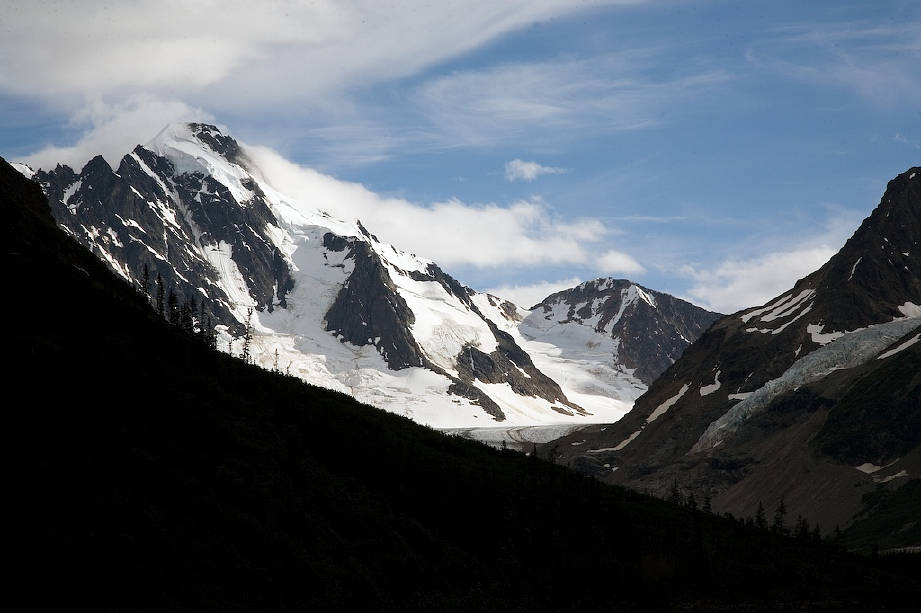
As progressed around a bend, we spotted Quattrin glacier for the first time. With the aid of his long lens, Mike gathered beta for us to mull over later. White Rabbit could be seen in the photo, dominating the west (left) side of the glacier. The col we were heading for was still out of the picture, but the route we'd try climb was visible. It looked rather long. We'd need good rock and a fair amount of luck for it to happen. But that was several days off still
.
We moved upstream until 5:30 pm, four or five hours from leaving Yehiniko, and passing 60 stream fords, before deciding to camp for the night. The skies had clouded and a light drizzle fell for a few minutes here and there. An old, well loved MEC tent got tossed up quickly and firewood gathered. We wouldn't be able to have a fire for a long time, and the opportunity for warmth was not going to be missed. There was plenty of dead wood that had been brought down the valley by the spring floods, which looked like they had occurred only a few weeks ago. We made soup and started the fire and dinner as the drizzle increased to an out and out rain. Rather than stand around in the rain, we shut off the stove and made for the safety of the tent.
When we emerged 90 minutes later, the sky was dry once again and we could see a bit up and down valley. But only a bit. Our map told us we had made about half the distance to the start of Quattrin Glacier, which is what we had taken to calling the glacier dropping down from the col and forming Quatrrin Creek. Several thousand years earlier it had formed the valley itself. We ate around the fire, in the mist, and hoped for better weather tomorrow. Not that we needed it. Not yet, at least. There was only one way up the valley and if we wanted to go there, we'd have to hoof it, regardless of the weather. Mike mentioned his hurting wrist, but declined Vitamin I, sure that it would be okay in the morning. Our first day was done. 60 creek fords were done. One grizzly bear encountered. And a lot of wilderness traversed. Tomorrow we'd met the glacier, and leave living things before for the next two weeks.
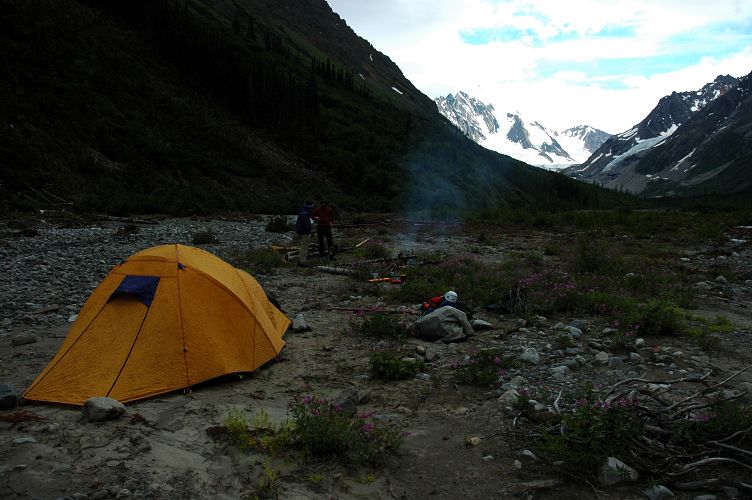
Rain. Rain is the bane of people who spend time in the outdoors. The sound of rain hitting something solid above your head is comforting, as long as you are inside. But, we had to eventually leave the tent and start for the col. It wasn't until 8:30 that we summoned enough courage to leave our bags and our dryness for the misty air outside. The rain had let up and we made a pot of retched Pu-Erh tea that Mike had had in his kitchen for three years. It tasted like water filtered through compost, but it would have to do. We moved slowly this first morning out, slowly eating breakfast and breaking down the soggy tent. Our boots, soaked from the 60 fords yesterday, were just as sodden as when we took them off the night before. But after moving for a few moments this wasn't too bad.
We were moving by 10:30, heading up the valley for the the glacier and the end of our flirtation with living things. For, once we reached the glacier, there would be nothing alive other than lichen and ourselves. There would be no scent other than our collective stench. As it turned out, we had done the majority of the fords yesterday and had only ten more to do.
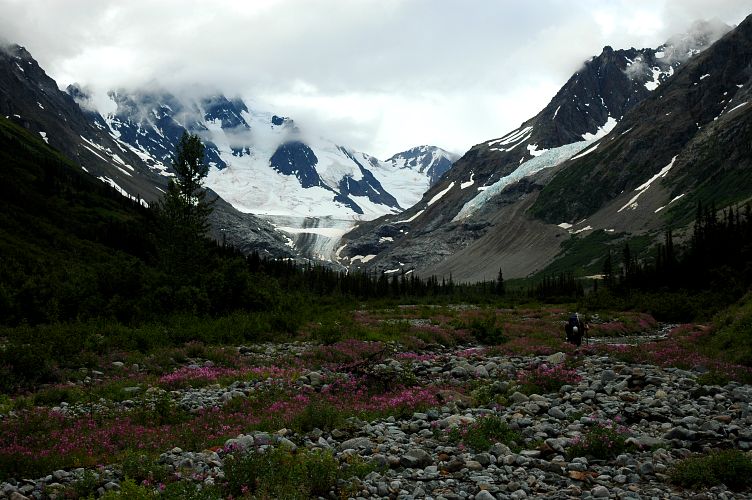
The walking was pleasant, with nice flowers here and there and some massive avalanche paths to cross. Several hundred yards long, the slide paths indicated that the snow had come down from high on one side of the valley, crossed the floor, and then gone high up the other side. As we neared the head, vegetation decreased and more and more rock became visible. The sky was iron grey, which was, in fact, helpful. Or, rather would be. Bright sun on a glacier was harsh, the reflected light burning any exposed skin.
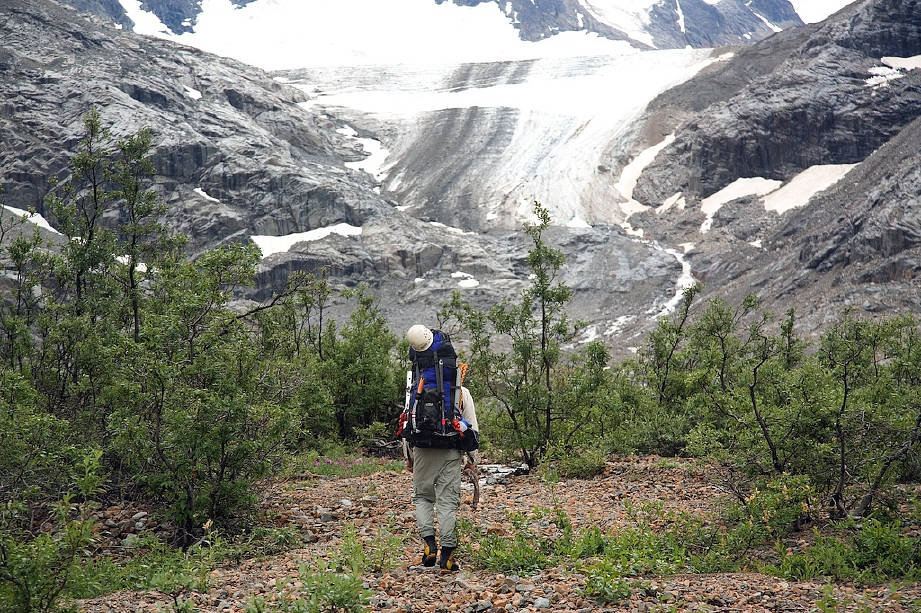
Around noon we reached the head of the valley and the falls that spilled off the glacier on rock polished smooth by the action of the ice. Looking down valley, we could see the land we had moved through. I mourned the coming loss of green, of smell, of life, but knew that we had to push up and into the land of the unliving, of rock and ice and snow. We sat for an hour in the shelter of a rock, hiding from the cold wind coming off of the glacier, eating energy bars and drinking the last of the glacial milk.
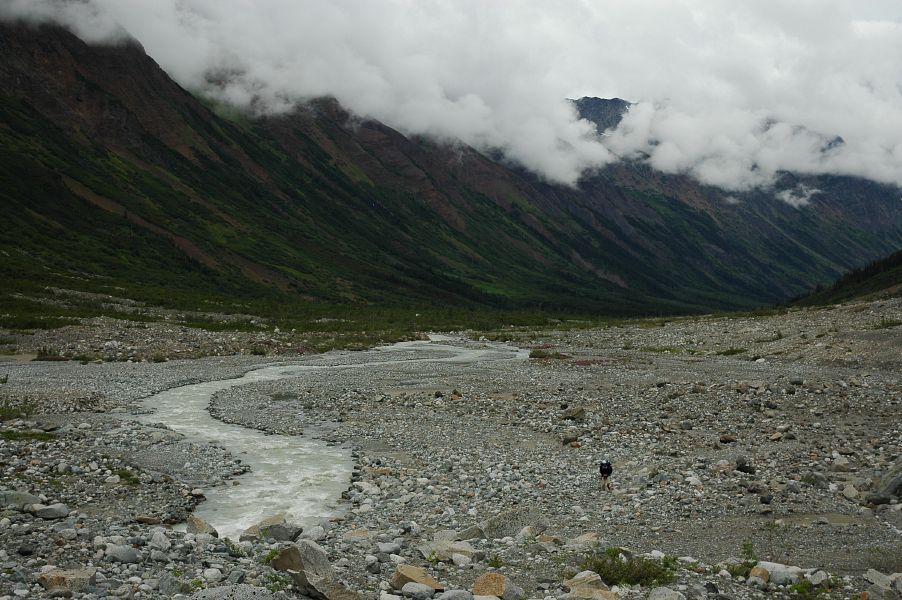
The route to the glacier held a bit of a surprise. Mike had come down off of the glacier three years ago and there had been no falls. The ice simply ended at the valley floor. Since then the glacier had retreated a hundred yards or more, exposing the falls. We would have to get up them to gain the glacier. It would not be fun.

We looked for alternate routes, but there were none. As close as it got was a massively broken up ice fall spilling down from another col. To try that route would be to die. And so we headed up the falls, traversing slabby rock when we could, gaining elevation when we had to. Mike and Bob, being Vancouverites, climb at Squamish quite a bit. The granite there includes many "slab" routes. Slab climbing is generally fairly long angle, with small foot holds and few hand holds. Climbing slab requires balance and for you to "trust your feet." My slab experience was minimal, and what slab I have climbed didn't include a 70 pound pack on my back. I was used to the volcanic basalt of Frenchmen's Coulee, or the massive featured limestone of Thailand. Where Mike and Bob moved confidently, I slowed to a crawl, moving like a little child over unfamiliar terrain, sweating and cursing and generally making a muck of everything.
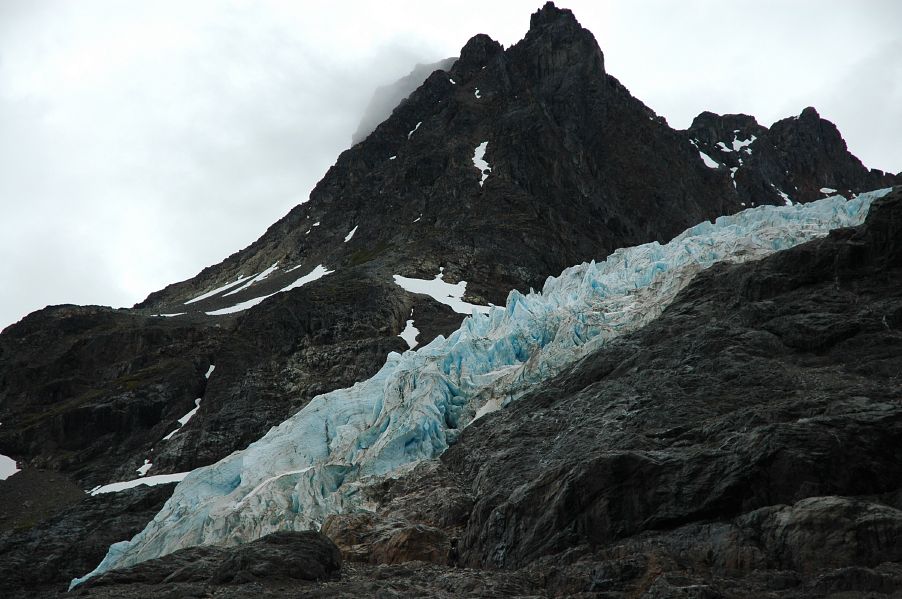
But with encouragement and help from the others, I slowly, and very ungracefully, made the climb up the slabby rock and onto a scree field that led to the foot of the glacier. Feeling frustrated at the slab, I moped in silence as we rested and the sun slowly began to peek out of the clouds. I knew that I shouldn't mope, that things would get better, but I was still disappointed in myself. If there was much slab in front of us, I wouldn't be climbing a whole lot.
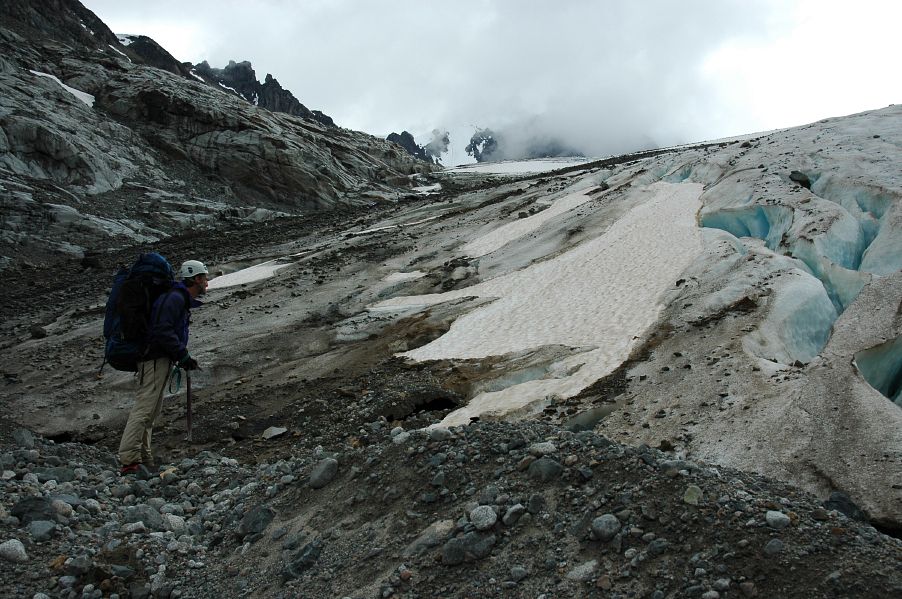
Mike and Bob were all smiles, though, and their joy slowly rubbed off on me. The view down the valley was superb from our vantage point, and the route ahead looked easy.
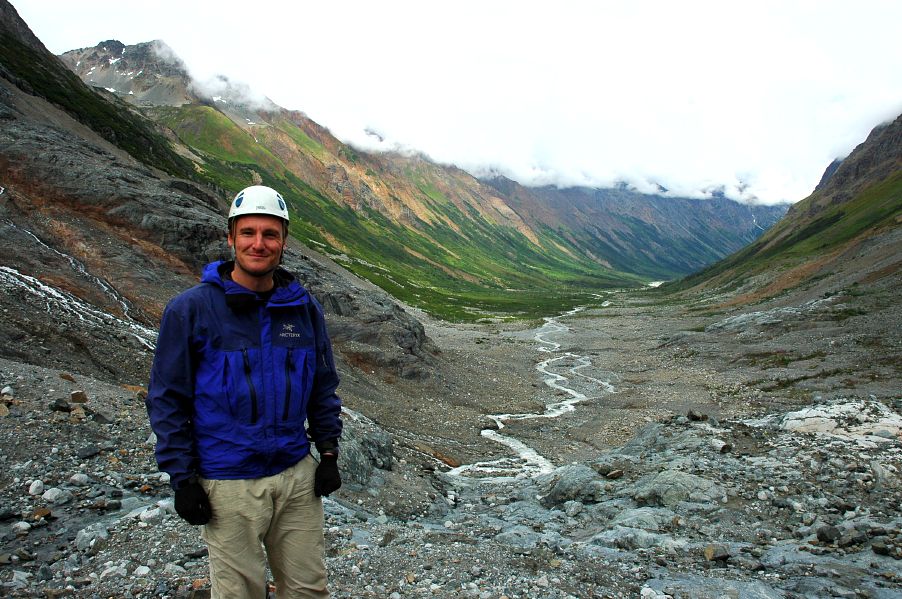
We donned crampons and got our axes out for the climb up the ice. The glacier was bare, which meant that crevasses were easily spotted and we declined to rope up. Now, I had been taught by the Mountaineers to always rope up on a glacier, but that simply didn't make sense here, as Mike pointed out. The purpose of the rope is so that if someone falls into a crevasse, the others can drive their axes into the glacier and arrest the fall. However, we were on bare ice and there is no way that any two of us could arrest the fall of the third: The axes would simply not be able to get deep enough into the ice. The end result of a fall would be for all three of us to end up in a crevasse instead of just one. The rope stayed in the pack.

We plodded up the glacier toward the increasingly blue skies, looking back occasionally at the foggy valley behind us. On the lower reaches of the glacier there were numerous rocks imbedded in the ice, rocks that the glacier had been slowly carrying down from the mountains over the years. Our crampons bit into the ice, providing solid footing on the moderate, 20 degree slope. It was, in short, the easiest walking of the trip so far.
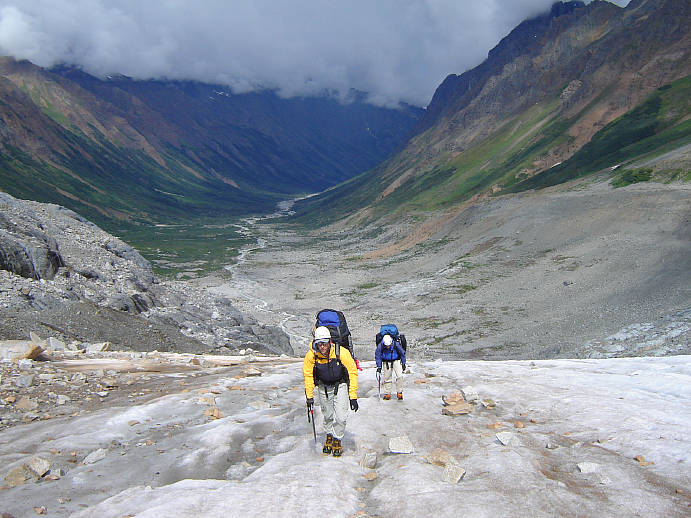
Indeed, if we hadn't been carrying heavy loads the walk up the glacier would have been considered a pleasant stroll. The few crevasses were open and obvious. There were nice spouts of water where we could stop and have a drink of pure icemelt. There were boulders to sit on when we got tired. And the sun warmed us just enough to be comfortable, not enough to burn. But this was a dead land, and as we gained elevation the green valley we had climbed out of slowly disappeared from view. Rock, ice, and snow. We were the only living things around us. Even the floor of Death Valley had livings in it. We, alone, were life.
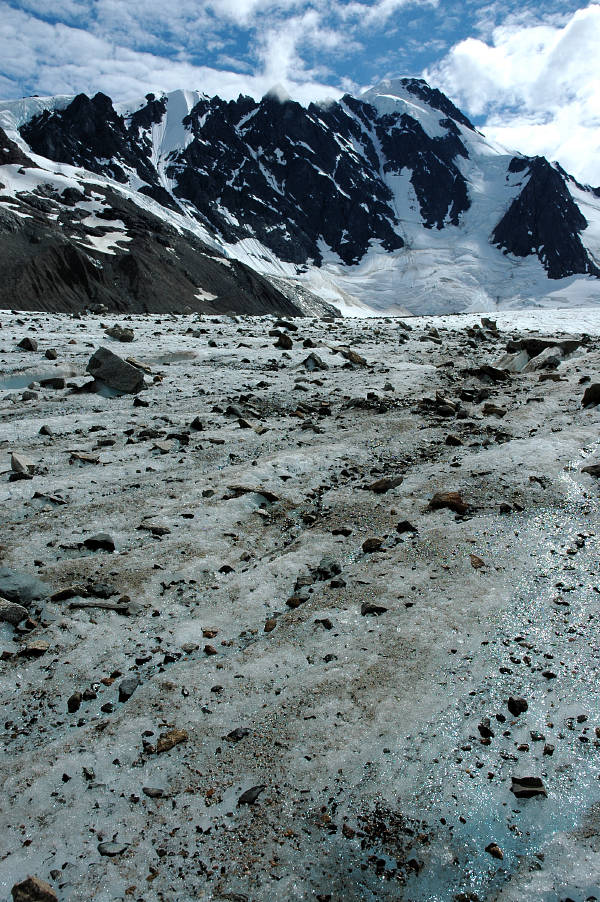
Quattrin glacier plateaued and the bare ice became increasingly snow covered, which meant that it was time to rope up for the first time. The possibility of a crevasse fall was higher, but our ability to arrest also increased. The sky was full blue over head as we brought out our skinny 8mm rope and tied in. But, we could see storm clouds coming in from the valley, bringing with them rain and general misery. Bob led out, with Mike in the middle and me in the rear. Bob, being in front, was the most likely person to fall in. Being the heaviest of the three of us, I was the most able to stop a fall. Mike's wrist was bothering him, so in the middle he went.

We moved over the snow to a thirty, perhaps thirty five, degree snow hill that lead to the col we were seeking. Moving slowly, we switchbacked up, Bob kicking big bucket steps for us to follow, and resting numerous times. However pleasant, our slow pace meant that the storm caught us just as we reached rock and took off our crampons. The storm, however, was not severe, but searching for a campsite in the rain is never fun. We looked around on our side of the col, but found nothing that was super appealing. Moving over to the top, we were greeted with mist and wind, instead of glorious views of the land ahead. However, we found a nice, big flat area formed by several huge slabs of rock. It was perfect, though where water would come from was another story. We quickly put the tent up, though by the time it was up, and ready to shelter us, the rain let off and the mist began to clear. The perfection of our campsite was obvious once the mist left us, giving us views down to Ambition and the Scud.
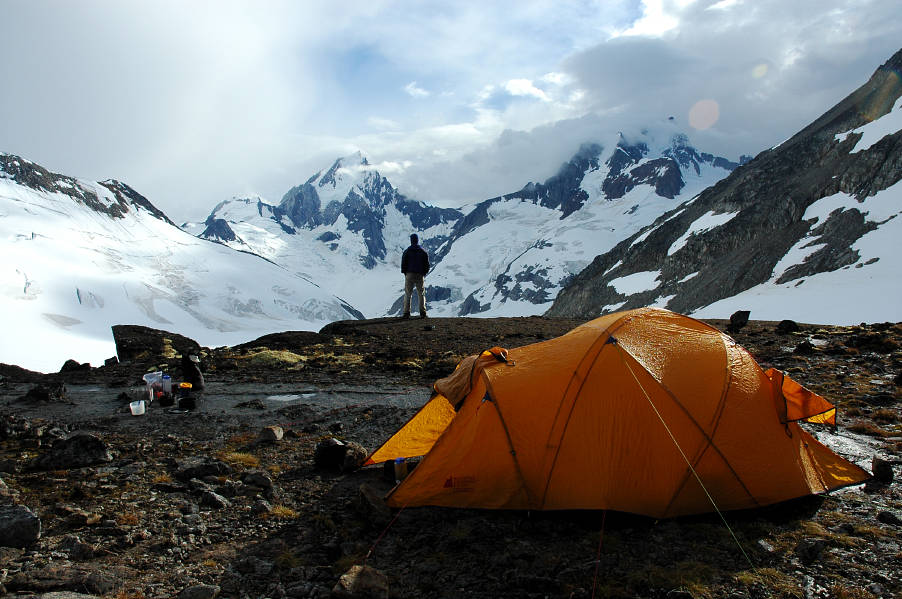
We brewed up two liters of soup to help with hydration and then wandered about our camp in all of its glory. Ambition looked terrifying on the other side of the Scud.

Our rock route up White Rabbit looked far longer and far more intimidating than it had from the plane, the approach, or on Mike's computer in Vancouver.

On the other side of the col stood a peak that looked scary from down low, but now seemed doable. We'd have to give it a run. Not only did it look fun, with a mixture of steep snow and rock, but it appeared to be within the collective abilities of the group.
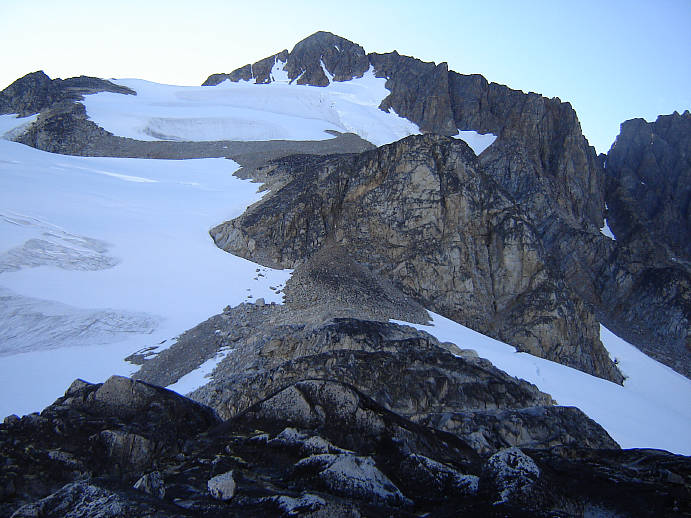
After a dinner of home made chili, cooked up several months ago and dried by Bob's mom, Mike and Bob set out to see how to get down to the glacier while I lounged and wrote. The sun had disappeared behind the mountains and it was cold, though still light. We were in real mountains now. The real thing. It was intimidating to be here, yet also appealing. The appeal was in the newness, in the unexplored nature of the place, in our self reliance. It was scary in the risk factor. In not knowing what we might find. Something bothered me as Mike and Bob were gone. Much of the appeal was an appeal to my ego: I felt proud that I was here. Part of the appeal was that, after we were done, my ego would ride high, that people back home would perceive me differently. I didn't like doing ego-boosting things. I wanted to live ego free. Yet, here I was, doing something that seemed like it would do exactly the opposite. I banished the ideas as Mike and Bob returned, proclaiming that they had found an easy route down to the snow. The growing cold banished us eventually to the tent. I tried to forget about egos and all that nonsense. I wanted to simply be here, rather than trying to boost something that I knew, or suspected, didn't actually exist except in my mind. I wondered if Mike or Bob had felt such things. But I did not have the courage to ask.
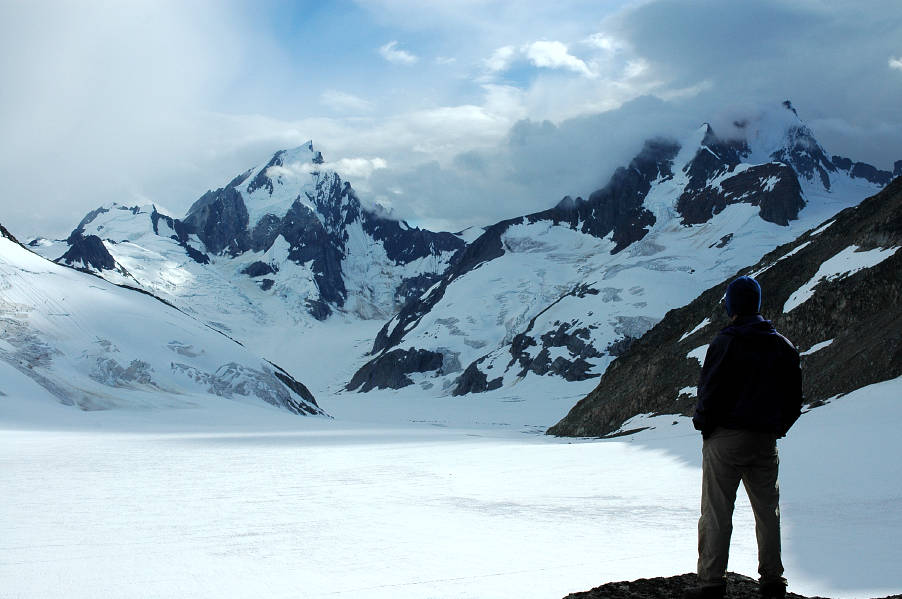
The glow inside of a yellow tent in the mountains is something that brings joy to every climber's soul. It means the sun is shining and life outside of the shelter is enjoyable. It wasn't until 8:30 that we emerged from the tent and the sun outside was just as warm as the stagnant air inside. We didn't have a big day planned. Indeed, all we were going to do was stroll over to our food cache, collect a few items, and then do some bouldering in the area. The hot Pu-Erh tea tasted just as wretched as the morning before, but helped wash down the dry square of Hudson's Bay bread that made up my breakfast.
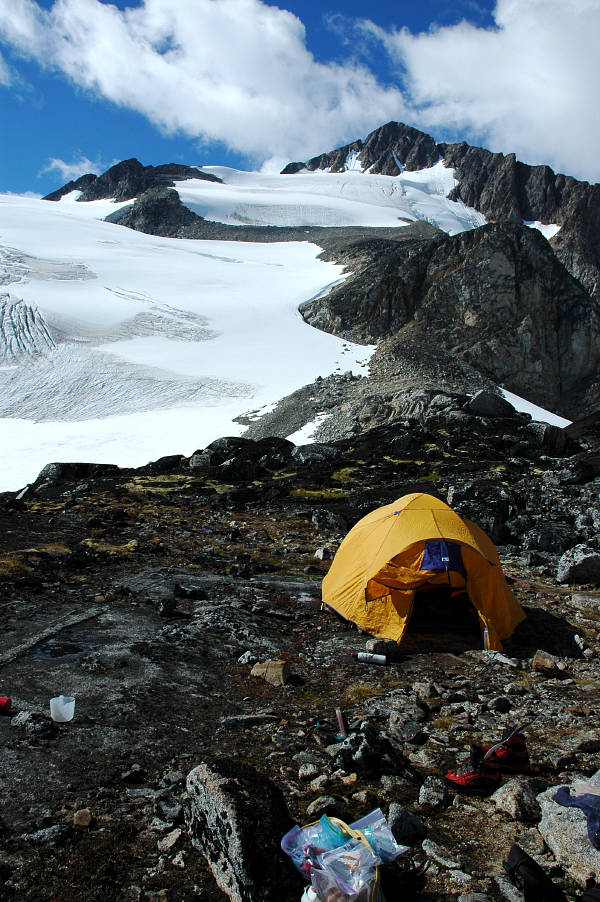
With pleasant weather, there was no rush. A little after 11 we finally scampered down the rocks and onto the side glacier that led from the col down to the Scud. Out came the rope and crampons and off we went. The glacier was snow covered with only a few minor crevasses to jump, with only one or two that were large enough to fall, partially, into. Conditions were looking very good. Immense Ambition dominated the skyline toward the Scud, with its massive east face looking even more like a death trap as we moved forward.

After a kilometer or so of moving down the glacier, we finally neared the Scud itself and got our first close up view of Endeavour, sitting just north of Ambition, but with an aspect all its own. Where Ambition soared like some sort of Gothic cathedral, vaulting high into the air, Endeavour gave off a feeling of strength and solidity, like a Romanesque church. Its east side looked jumbled and complicated, with icefalls and cliffs barring the way. If we were to climb it, it would have to be from the other side. North of Endeavour was an unclimbed black peak that we took to calling the Nipple, for its obvious relation to that particular piece of anatomy. A snow climb of its north ridge looked very feasible, going at a sustained 45-50 degrees. Enough to be interesting, not so steep to be frightening.
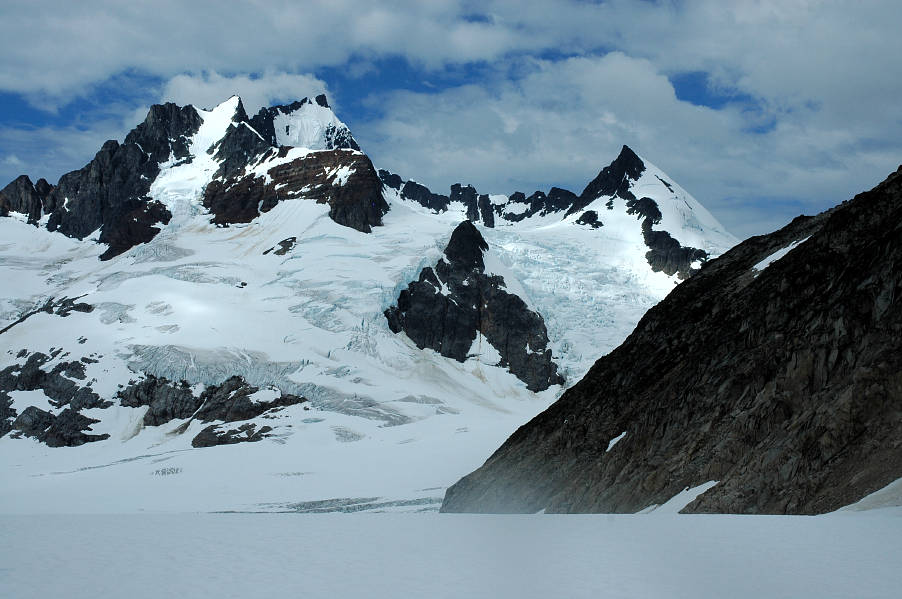
The downside of our camp was soon revealed to us as black storm clouds came rushing over the col from Quattrin Valley and dropped onto us. The weather was apparently coming in from the north and the east, exactly opposite to the pattern we thought should exist: Storms should blow in from the Pacific, not from inland. What we wanted didn't much matter. After entering the Scud we climbed over bare ice and around yawning crevasses (i.e, VW bus swallowers) to regain the snow at a slightly higher elevation. Even in the near whiteout that we were now in, the red dry bags could be made out from several hundred yards away and ninety minutes after setting out, we were standing next to them.

With light rain falling and no sign of the storm letting up, we quickly dove into the bags and fished out the little bit of food we needed and our rock pro. There were a few broken bags, and my sesame sticks seemed pulverized into a fine dust, but the drop had been successful on the whole. Two of the bags had rips in them, one caused by the pitons, then other by some unknown force. Maybe from a 400 foot fall out of a plane. We resealed the bags and were moving back to toward the col within 10 minutes of arriving.
Using our tracks as a guide, we quickly retraced our steps up the glacier, moving a little slower than on the descent. When we reached the side glacier that led to the col and our camp, the rain slackened and then died, the mist began to lift. By the time we were within sight of the tent, the sun was beginning to peak out from the clouds. And when we sat down to take off our crampons and the rope, it was warm and pleasant once again. It wasn't even three in the afternoon, which meant that we had plenty of time to lounge and relax and get ready for tomorrow, which promised to be a big day.
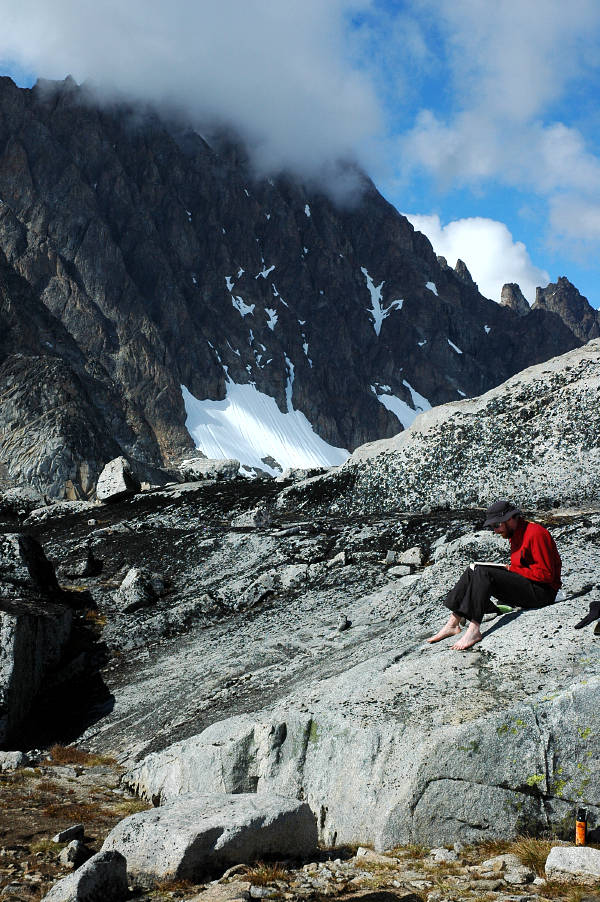
The west ridge of White Rabbit looked long and sustained. Things usually look harder from far away, and I hoped that what seemed to be a narrow ridge was, actually, wide and pleasant, with good scrambling on solid rock. As Bob sat in the sun and read a book, I sat in the sun and contemplated White Rabbit and the odd preoccupation that humans seem to have with doing foolish things, like climbing mountains.

The weather wasn't done with us yet, however, and around five another storm blew up Quattrin Valley and hammered us with hail and rain, but this time we had the protection of the tent. The storm lasted less than an hour and we were back out in the sun drinking soup and marveling at the fine weather. With nothing else to do, we attacked the local boulders with our mountaineering boots, working on slab climbing and jamming, flagging and manteling, a technique also known as grovel and pray, according to Mike. We scampered around and around, finding ten new problems for every one that we solved, though we eventually had to call it quits and actually eat dinner and prepare for tomorrow.

We split up group gear, like ropes and rock pro, and we each stuffed what we thought we'd need for the next day into our packs. Alpine starts never go well if you're packing in the frigid, dark morning air. I was nervous, as I always am before a climb, but also content. If we could pull it off, the west ridge would be a fabulous climb and our first ascent, at least for Bob and I. As always I reminded myself of where my priorities were. First, be safe. Second, have fun. Third, make the summit. I was pretty sure that Mike and Bob had the same list, and that helped assuage the nervousness. Mike had vastly more experience than either Bob or I at such things, so what seemed safe to him might spook one or both of us greatly. During our climb of Mount Rexford, this was quite clear. Though, I must admit, he had been right on that occasion. Hopefully the same would be true tomorrow.
